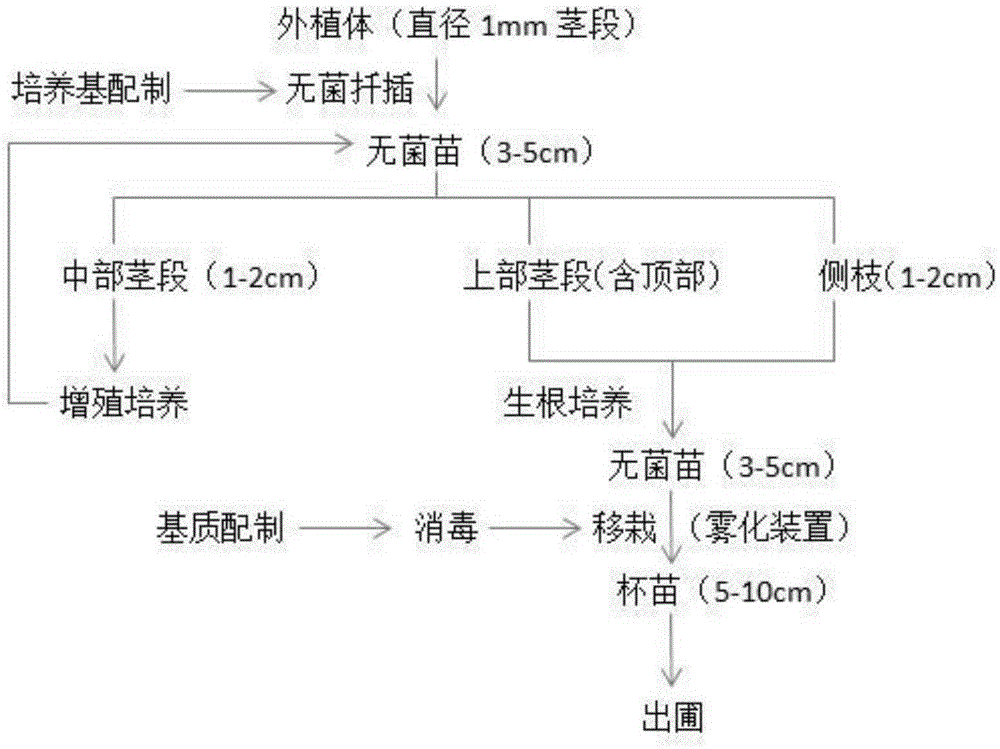Method for sterile cottage and rapid seedling propagation and raising of Australian melaleuca alternifolia
A technology for fast-growing seedlings and camellia oil trees, which is applied in the field of economic forest tree seedling raising, can solve the problems of expensive imported seeds, low reproduction rate, large influence, etc., and achieves the effects of high cutting efficiency and improved reproduction efficiency.
- Summary
- Abstract
- Description
- Claims
- Application Information
AI Technical Summary
Problems solved by technology
Method used
Image
Examples
Embodiment 1
[0055] (1) Selection and processing of explant materials:
[0056] When the weather is fine, select young stems from Australian tea oil tree saplings that are free from diseases and insect pests, grow vigorously, and have a diameter of less than 1 mm; cut the young stems into 3 cm lengths, place them under tap water, and stir them While rinsing for 1 hour, first disinfect the surface with 75% alcohol by volume on the ultra-clean workbench for 30 seconds, and then use 0.1% HgCl 2 Disinfect for 6 minutes, rinse 5 times with sterile water for use;
[0057] (2) Establishment of sterile strains for the first time:
[0058] Cut the young and tender stems after the disinfection treatment in step (1) into 2cm long stems, then insert them vertically into the medium according to the growth direction, cut 5 sections in each medium, place them in a room with a temperature of 25°C and an illumination of 2000lx. Cultivate in the environment, 10h light / 14h dark every day; cultivate for 8 w...
Embodiment 2
[0066] (1) Selection and processing of explant materials:
[0067] When the weather is fine, select young stems from Australian tea oil tree saplings that are free from diseases and insect pests, grow vigorously, and have a diameter of less than 1 mm; cut the young stems into 2 cm lengths, place them under tap water, and stir them While washing for 2 hours, first use 75% alcohol to disinfect the surface for 60 seconds on the ultra-clean workbench, and then use 0.1% HgCl 2 Disinfect for 7 minutes, rinse with sterile water 4 times for use;
[0068] (2) Establishment of sterile strains for the first time:
[0069] Cut the young stems after disinfection in step (1) into 1 cm long stems, then insert them vertically into the culture medium according to the growth direction, cut 5 sections in each culture medium, place them in a room with a temperature of 25 °C and an illumination of 1500 lx. Culture in the environment, 10h light / 14h dark every day; culture for 13 weeks;
[0070] ...
Embodiment 3
[0077] (1) Selection and processing of explant materials:
[0078] When the weather is fine, select young stems from Australian tea oil tree saplings that are free from diseases and insect pests, grow vigorously, and have a diameter of less than 1mm; cut the young stems into 2.5cm lengths, place them under tap water, and Rinse while stirring for 1.5h, first use alcohol with a volume fraction of 75% to carry out surface disinfection for 40s on the ultra-clean workbench, and then use 0.1% HgCl 2 Disinfect for 6.5 minutes, rinse with sterile water 7 times for use;
[0079] (2) Establishment of sterile strains for the first time:
[0080] Cut the young stems after disinfection in step (1) into 1.5cm long stems, then insert them vertically into the medium according to the growth direction, cut 5 sections in each medium, place them at a temperature of 25°C, and an illumination of 1800lx Cultivated in an environment with 10h light / 14h darkness every day; cultured for 10 weeks;
[...
PUM
| Property | Measurement | Unit |
|---|---|---|
| Length | aaaaa | aaaaa |
Abstract
Description
Claims
Application Information
 Login to View More
Login to View More - R&D
- Intellectual Property
- Life Sciences
- Materials
- Tech Scout
- Unparalleled Data Quality
- Higher Quality Content
- 60% Fewer Hallucinations
Browse by: Latest US Patents, China's latest patents, Technical Efficacy Thesaurus, Application Domain, Technology Topic, Popular Technical Reports.
© 2025 PatSnap. All rights reserved.Legal|Privacy policy|Modern Slavery Act Transparency Statement|Sitemap|About US| Contact US: help@patsnap.com

